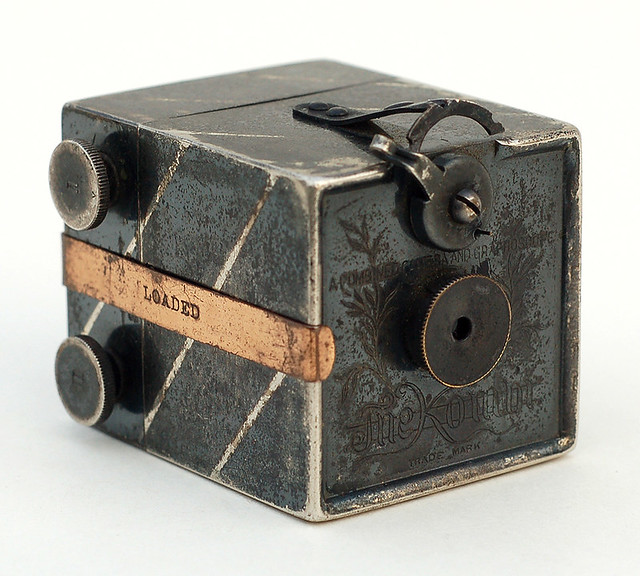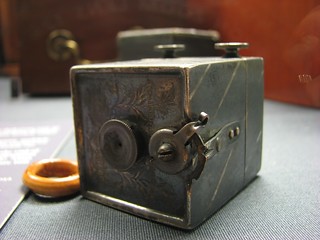Difference between revisions of "The Kombi"
(Updated 'image=' URL for broken picture) |
m (→Links: Updated LPA link) |
||
| (2 intermediate revisions by the same user not shown) | |||
| Line 8: | Line 8: | ||
}} | }} | ||
| − | '''The Kombi''' was the first non-Kodak roll film camera for which [[Kodak]] produced its own type of film. It was made by '''Alfred C. Kemper''' of Chicago, Illinois USA, after the American William V. Esmond received a patent on it in England in 1892. Kemper and Esmond shared the rights on this successful 1890s miniature box camera that could make 25 exposures in 1 1/8×1 1/8" square format on one roll of | + | '''The Kombi''' was the first non-Kodak roll film camera for which [[Kodak]] produced its own type of film. It was made by '''Alfred C. Kemper''' of Chicago, Illinois USA, after the American William V. Esmond received a patent on it in England in 1892. Kemper and Esmond shared the rights on this successful 1890s miniature box camera that could make 25 exposures in 1 1/8×1 1/8" square format on one roll of transparency film (that is, developed with a positive image). It was an all-brass construction. Different aperture plates could be mounted over its lens opening. It's main advantage was the exchangeable roll film magazine as camera back. The magazine with the exposed film had to be sent to the factory for film development and reloading. The camera was sold by the tens of thousands. |
"Kombi" meant that the camera's film magazine could be loaded with a developed film and then be used as film viewer (graphoscope). That made the camera being a combination of both, a camera and a viewer. | "Kombi" meant that the camera's film magazine could be loaded with a developed film and then be used as film viewer (graphoscope). That made the camera being a combination of both, a camera and a viewer. | ||
| Line 24: | Line 24: | ||
*[http://www.submin.com/large/collection/kombi/introduction.htm The Kombi] at [http://www.submin.com submin.com] | *[http://www.submin.com/large/collection/kombi/introduction.htm The Kombi] at [http://www.submin.com submin.com] | ||
*[http://www.vintagephoto.tv/kombi.shtml The Kombi] at [http://www.vintagephoto.tv/index.shtml Scott's Photographica] | *[http://www.vintagephoto.tv/kombi.shtml The Kombi] at [http://www.vintagephoto.tv/index.shtml Scott's Photographica] | ||
| + | *[https://www.leitz-auction.com/en/Kemper-Chicago-The-Kombi/AI-39-39633 Kombi] sold at the [https://www.leitz-auction.com/en/Cameras/Past-Auctions/Auction-39/ 39th Leitz Photographica Auction], in November 2021. | ||
Latest revision as of 13:45, 4 January 2024

|
| Kemper Kombi with optional reminder clip image by John Kratz (Image rights) |
The Kombi was the first non-Kodak roll film camera for which Kodak produced its own type of film. It was made by Alfred C. Kemper of Chicago, Illinois USA, after the American William V. Esmond received a patent on it in England in 1892. Kemper and Esmond shared the rights on this successful 1890s miniature box camera that could make 25 exposures in 1 1/8×1 1/8" square format on one roll of transparency film (that is, developed with a positive image). It was an all-brass construction. Different aperture plates could be mounted over its lens opening. It's main advantage was the exchangeable roll film magazine as camera back. The magazine with the exposed film had to be sent to the factory for film development and reloading. The camera was sold by the tens of thousands.
"Kombi" meant that the camera's film magazine could be loaded with a developed film and then be used as film viewer (graphoscope). That made the camera being a combination of both, a camera and a viewer.

|
| image by Peter Repetti (Image rights) |
Links
- The Kombi at submin.com
- The Kombi at Scott's Photographica
- Kombi sold at the 39th Leitz Photographica Auction, in November 2021.
| Companies of Chicago (Illinois) |
| Adams & Westlake | Central Camera Co. | American Advertising and Research Co. | Bernard | Burke & James | Busch | Calumet | Candid | Chicago Aerial | Chicago Camera Co. | Chicago Ferrotype Company | Deardorff | De Vry | Drucker | Galter | Geiss | Herold | Imperial | Kemper | Lennor Engineering Co. | Metropolitan Industries | Monarch | Montgomery Ward | Pho-Tak | QRS Company | Rolls | Sans & Streiffe | Sears | Seymour | Spartus | The Camera Man | United States Camera Co. | Western Camera Manufacturing Co. | Yale | Zar | Zenith |
| Chicago in depth: The Chicago Cluster, a bakelite trust? |